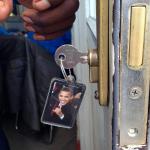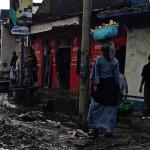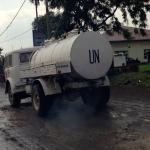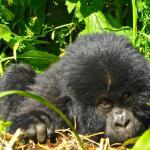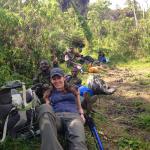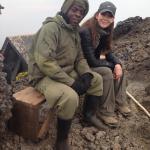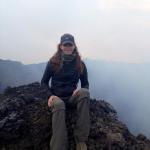© 2011 Sabrina Swenson. All Rights Reserved.
Rwanda and the Democratic Republic of Congo
January, 2015
Mention Rwanda and most people think of the horrific genocide that brutalized the tiny country in 1994. Back then, Rwanda's population of seven million was composed of three ethnic groups; 85% Hutu, 14% Tutsi and 1% Twa or Batwa. In the early 90's, Hutu extremists blamed the entire Tutsi population for Rwanda's increasing economic, social and political problems. Through the use of propaganda, then President Juvenal Habyarimana (a Hutu) and his group increased the devision between Hutu and Tutsi. Remembering past years of oppressive Tutsi rule, many Hutu resented the Tutsi. On April 6, 1994 the president's plane was shot down and violence began. Hutu extremists launched a plan to destroy the entire Tutsi population. Tutsi were killed in their homes and as they tried to flee. In a span of a mere 100 days, an estimated one million Tutsi and moderate Hutus were butchered.
Since those dark days, Rwanda has gone through an incredible transformation. The Rwanda of today is a peaceful place of unity, smiling people and is incredibly clean for an African country.
My journey began with a flight into the capital, Kigali where I established myself at a local guesthouse. My first full day was spent at the Kigali Memorial Center. I hopped a moto-taxi (motorcycle taxi) to the Center. The Memorial honors 250,000 people buried there in mass graves and explains how the genocide unfolded. Life size photos show scenes from the time as the visitor is given an account of the events. A rose garden has been planted amongst the mass graves, giving it a hint of beauty. There's also a large black wall which has been erected with the names of the victims much like the Vietnam Memorial in Washington, DC. The memorial is very well done and gives the individual visiting a clear picture of how and why the genocide unfolded.
After a very somber several hours at the Memorial I sat down for a coffee to contemplate such a horrible event that took place not so long ago. It's hard to imagine neighbors killing neighbors and friends killing friends simply because of their ethnicity. A favorite book of mine is "Left To Tell" by Immaculee Ilibagiza, a Tutsi survivor of the genocide. In it she talks about how she survived to tell her story by hiding in a pastor's small bathroom with seven other starving women for 91 cramped, terrifying days. The door to the small space was hidden behind a piece of heavy furniture. It is a moving and gripping book. If you think you're having a bad day, read this! You will never complain again.
On other not-so-somber days in Kigali, I enjoyed the uniqueness of this city that is built on a number of ridges and valleys.
After taking in Kigali I headed to the cacophony that is Nyabugogo bus station to look for a vehicle headed North to the town of Musanze. After sifting through the mass amount of people and vehicles I finally found one headed in the right direction. Although buses don't leave until every seat is full, I lucked out and was one of the last to board. Although I was quite happy to sit in the middle with all the locals, they often make space for foreigners up front. And so, after they cleared a path through the crowded bus, I took my seat behind the driver. A few hours later and I was in the Northern city of Musanze. Since Rwanda is such a small country, it doesn't really take long to get anywhere.
After finding a guesthouse, I explored the town on foot and noted the beautiful Virunga volcanoes looming in the background. I stayed at a hotel that used to be frequented by Dian Fossey the famous zoologist who studied mountain gorillas. They left her room exactly as it was when she stayed there.
After a couple days in Musanze I hopped another bus to the boarder town of Gisenyi for the reason I came on this trip, to enter the Congo! The Democratic Republic of the Congo or DRC is a large country in Central Africa formerly known as Zaire. Although it's a country rich in natural resources, its extreme political instability and a culture of corruption have limited it's development. A trip to the DRC certainly isn't for everyone!
After clearing immigration formalities on the Rwanda side, I walked across the border with my backpack into the DRC. I waited at their immigration window and while they were processing my paperwork I noticed the door to the office was open and the key was in the door. I chuckled as I saw a picture of President Obama on the keychain. I waited a while longer and they finally stamped my passport and I walked on into the Congo. I hailed a moto-taxi and had him take me to a guesthouse in nearby Goma which I had picked from my travel book. I purposely picked a place on the edge of town right on Lake Kivu, not only because it had a beautiful view of the lake but also because tension was running high that day due to political events going on in the country. I checked with local sources and was told foreigners were to be on high alert that day due to possible political demonstrations. As I rode on the back of the moto-taxi I saw UN vehicles everywhere as well as small trucks filled with fatigue clad rebels with the largest weapons I had ever seen. Once at my guesthouse, I was a bit disappointed that the electricity was sketchy at best and there was no running water, just a large bucket of cold water next to the bathtub. The toilet seat was broke in two with half of the seat missing all together and the mosquito net had large holes in it in numerous places. Ahh, the DRC. The only other guests in my guesthouse were UN peacekeepers which was evidenced by their light blue berets with the symbol of the UN. I ventured out on foot but not for long that day as tensions were high. Remnants of nearby volcano Nyiragongo, which blew it's stack in 2002, are still evident in Goma. Half of the city was destroyed by the lava flow with much of the lava remaining today.
The following day I started early and was picked up by a vehicle for the drive to one of the highlights of my trip, trekking mountain gorillas! My first encounter with these beasts was in Uganda back in 2006. It was an incredible experience and I wanted to once more be in their presence. Since only about 720 mountain gorillas exist in the world today, this is an incredible experience. The only place in the world to see gorillas in their natural habitat is Uganda, Rwanda or the DRC. And so, my vehicle bounced down the road to Virunga National Park. The only good news about the country being so unstable was that I was the only tourist that day for the gorillas. As such, there was no jockeying for position when taking photos as I was the only one there besides my guide and the trackers.
To trek mountain gorillas, the trackers leave early in the morning in search of a gorilla family. It sometimes takes hours for them to find a family in the thick brush. Once found, they stay with them as they move and radio back to the park rangers their position. Once I arrived we set off into the jungle on foot, my guide hacking our way through the thick vegetation. There are no paths here! A large machete is used to cut through the heavy brush. Heavy pants and long sleeves are needed as there are numerous thorns, bushes, etc. After about 50 minutes we came across a family. There was one silverback (the dominant male whose hair turns silver on their back once they reach maturity) as well as a couple females and several babies. I watched in great amusement as the babies played, rolled and climbed all over the adults.
There are many rules when gorilla trekking. One must maintain a distance from the gorillas, no flash photography, no coughing, eating, drinking, smoking and in the DRC one must wear a surgical mask while in their presence. Since gorillas are 98.6% of the same nuclear DNA as a human, it is possible to transmit disease between species. The most important rule, of course, is if the silverback ever charges, DO NOT RUN! Instead, you just take the submissive position; head down, eyes averted, basically curled up in the fetal position, until he cools off. The gorillas didn't seem too interested in me as I gawked at them taking photos. Alas, photographing gorillas is not that easy as they often move resulting in blurred pictures as well as the fact that you are often shooting straight into the sun. Walking around them for a better angle is not usually possible in the thick vegitation. The babies were the most fun to watch as they not only climbed all over the adults but would also often roll to get around. In the thick brush, their tiny legs were simply too short to walk efficiently and so they would usually just roll to wherever they wanted to go. Often when I was moving through the jungle my leg would drop down through the brush to my knee as it was so thick and dense. Time with the gorillas is limited to one hour as they don't want them getting too used to humans. And so, after an hour with them we were headed out of the jungle and back to Goma.
The next day I woke and was off to the second highlight of my trip; a trek up the active stratovolcano Nyiragongo! Yes, the same volcano that destroyed half of Goma back in 2002. I hired a driver and he delivered me to the base of the volcano. I had the good fortune of running into the one tourist who had climbed the volcano the day before as he finished his trek. I asked how it was and he said cold! He also suggested taking a walking stick as the volcanic rock is very slippery. I was happy to get this advice and since they were selling walking sticks right there (supply and demand) I purchased one. The only other tourist going up the volcano that day was a young American guy. Once I obtained a porter, the group; the armed guide, porter, cook and the two of us tourists started the big trek up the volcano. At 11,382 feet Nyiragongo was a beast to climb in one day. Of course the base is at approximate 4,000 feet but the trek up in 5 1/2 hours was exhausting. Our guide seemed hell bent on recreating the Bataan Death March as he stormed off towards the top. The other American and I, not used to climbing volcanos every day, were huffing and puffing trying to keep up. We did have a few breaks on the way up and would often just collapse on the ground and lay there panting. At one point the temperature immediately dropped as the elevation increased and we found ourselves instantly freezing. We all stopped and immediately put on more clothing. Our guide covered up with his coat and donned a face mask. This, along with the AK47 he was carrying, made him look like a terrorist or at least someone going to knock off a liquor store! We eventually made our way to the top and were greeted by eight tiny A-frame huts which would be our home for the night. Each hut had a tent inside but no insulation what-so-ever! The huts weren't exactly well maintain, and although mine had a large metal lock, it was completely rusted and couldn't be used. I, instead, got a string and tied the door shut for the night! Once I stored my backpack in the hut, I climbed up a few feet more to the lip of the crater. When I looked down into the volcano you could see the red, hot lava lake swirling and making different designs. It was smoking and made a constant sound much like the ocean. The best view, however, was after the sun went down. In the pitch black of night in the DRC, the entire sky over Nyiragongo was a flaming orange/red. Mixed with the sound it was an eerie place to be sleeping just a few feet away from the crater's edge in my tiny hut!
After a short night spent mostly awake, due to the below freezing temperatures, we had a bite to eat with coffee and then packed up for the trek down. The beginning of the descent is when the walking stick came most in handy. The volcanic rock was very slippery and both the other American and I landed on our butts more than a couple times going down. As we hit the lower altitude we stripped off our coats and gloves and once again were in the heat of the DRC. Once at the bottom, I looked back at this beast of a volcano, Nyiragongo and said goodbye before heading back to my hotel.
I spent another day around Goma but with not much to see or do there, I eventually made my way back to the border and back to Rwanda. From there I found another minibus to Kigali and was once again back home in Frankfurt.
I had wanted to do this trip for some time, but since the Virunga National Park had been closed due to rebel fighting, I had to wait quite a while to go. Once the park opened, I jumped at the chance. It was definitely worth the wait! The Congo may not be for everyone, but I was not disappointed!

